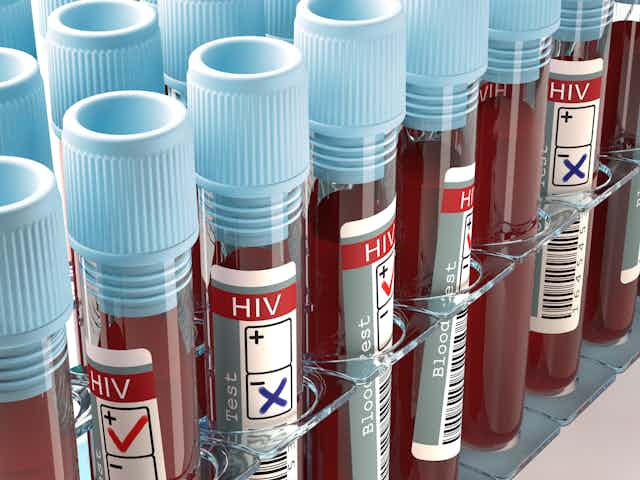Being diagnosed with HIV is a confronting experience.
However the stigma associated with HIV infection – a hangover from its social and medical history – is responsible for an exaggerated perception of transmission risk through sex, and the harms of living with HIV infection.
In our consensus statement published this week in the Medical Journal of Australia, we detail the latest evidence on HIV transmission risk and recent advances in HIV prevention and treatment.
We propose that legal cases relating to HIV transmission should be considered in light of such evidence, and that alternatives to prosecution such as the public health management approach are often appropriate.
HIV infection no longer a death sentence
There have been many advances in HIV diagnosis, prevention and treatment since the identification of the first AIDS cases in the early 1980s.
In the initial days of the AIDS epidemic, patients would, after a number of years, develop serious infections and other illnesses due to their immune deficiency, usually resulting in death. When the first treatments became available, they bought time but often at the cost of serious medication side-effects, and complicated treatment regimens involving many tablets each day.
While it remains a serious infection, HIV is now a disease that can be effectively managed through medical treatment, regular health monitoring and healthy lifestyle. For many people with HIV, treatment involves taking only a single pill each day. Those taking antiviral therapy can expect to live a normal life, in good health, with a life expectancy similar to their HIV-negative counterparts.
These great improvements, familiar to those working in health, are not as well understood in the legal sector.
Prosecutions for HIV infection
Unlike other diseases, HIV has a long and uneasy relationship with criminal law. In the early years of the epidemic, the stigma around HIV, the fact that it was almost always fatal, and unfounded fears about its potential use as a weapon led to the criminalisation of HIV transmission and exposure.
Since 1991, there have been more than 38 criminal prosecutions for HIV transmission or exposure during sex in Australia. Despite the significant improvements in health and longevity of people living with HIV, the rate of criminal prosecutions has not decreased.
The courts have shown an understanding of the effectiveness of condoms: no one who has used condoms has been convicted. However, people continue to be prosecuted, including for “exposing” others to the risk of HIV infection, even in the absence of actual transmission. This occurs despite the relatively low per-act risk of HIV transmission and the fact that for most people the harms of HIV infection are far less serious than they once were.
New approaches to limit HIV transmission
HIV is actually difficult to transmit. Sexual transmission occurs during only about 1% (or less) of penetrative sexual encounters, even when a condom is not used and the HIV-positive person is not on treatment.
HIV prevention messaging in the early days of the epidemic focused on sexual abstinence and condom use. However, prevention messaging is now more nuanced and has expanded to include new ways of reducing HIV transmission risk. A not insignificant number of people at risk of HIV infection choose to have sex without using a condom, which is why developing alternative methods of HIV prevention have been prioritised in recent years. Such research has delivered game-changing results: “treatment as prevention” and “pre-exposure prophylaxis”.
Treatment as prevention refers to the greatly reduced risk of HIV transmission as a result of HIV-positive people taking antiviral treatment, which suppresses replication of the virus in the infected person’s body. When a person with HIV has a very low viral load (unmeasurable levels of HIV in the blood), the risk of sexual transmission becomes very low. In fact, there has never been a documented case of HIV transmission from a person with an undetectable viral load.
Pre-exposure prophylaxis describes the use of antiviral medication by an HIV-negative person as a way of preventing HIV infection. Pre-exposure prophylaxis is a very effective means of preventing HIV transmission, with only isolated cases of transmission identified among people applying this approach. This groundbreaking new strategy is available in Australia via limited pilot programs, and is being evaluated for Pharmaceutical Benefits Scheme listing.
How the law treats people with HIV
Criminal laws relating to HIV transmission and exposure vary from state to state, but a common factor is that people with HIV are expected to take “reasonable precautions” to prevent transmission. Condom use has long been accepted as meeting this threshold.
The evidence now supports acceptance of treatment as prevention (for the positive partner) and/or pre-exposure prophylaxis (for the negative partner) as meeting the same standard. And the limited harms of HIV infection as a consequence of acts involving low to negligible risk of transmission mean HIV cases generally do not belong in criminal courts.
There is an alternative. All states and territories have health protocols for managing allegations of risky behaviour. This public health approach – involving education, case management and, where required, behavioural orders and isolation – is a much more effective way of protecting public health.
As researchers and clinicians, we are intimately aware of the impact an HIV diagnosis can have. We have all supported patients coming to terms with an HIV diagnosis; many of us having had the painful task of delivering that devastating news.
The criminal law has a role to play, particularly should there ever be a case where a person deliberately transmits HIV.
However, with the advances of recent years in both prevention and treatment, authorities need to be more familiar with latest scientific and medical evidence, and consider alternatives to prosecution such as the public health management approach.
Elizabeth Crock, Australasian Society for HIV, Viral Hepatitis and Sexual Health Medicine, co-authored the consensus statement.


